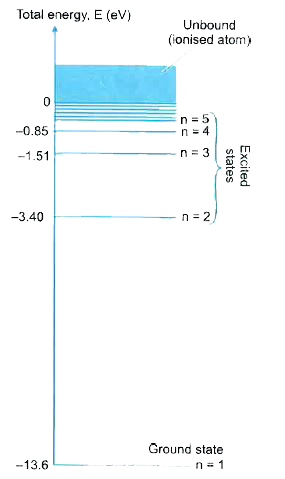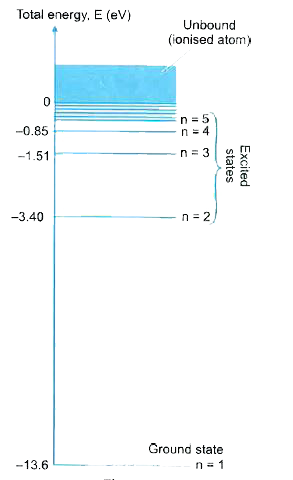Energy E of a hydrogen atom with principal quantum number n is given by En=−13.6n2eV. The energy of a photon ejected when the electron jumps from n=3 state to n=2 state of hydrogen is approximately.
1.5 eV
0.85 eV
3.4 eV
1.9 eV
The correct Answer is:A
Topper's Solved these Questions
Similar Questions
Energy E of a hydrogen atom with principle quantum number n is given by E=−13.6n2eV. The energy of a photon ejected when the electron jumps from n=3 state to n=2 state of hydrogen is approximately
View SolutionThe ionisation energy of hydrogen is 13.6 eV . The energy of the photon released when an electron jumps from the first excited state (n=2) to the ground state of hydrogen atom is
View Solution
Knowledge Check
- Question 1 - Select One
Energy E of a hydrogen atom with principle quantum number n is given by E=−13.6n2eV. The energy of a photon ejected when the electron jumps from n=3 state to n=2 state of hydrogen is approximately
A1.5eVB0.85eVC3.4eVD1.9eV - Question 2 - Select One
Energy E of a hydrogen atom with principle quantum number n is given by E=−13.6n2eV. The energy of a photon ejected when the electron jumps from n=3 state to n=2 state of hydrogen is approximately
A1.5eVB0.85eVC3.4eVD1.9eV - Question 3 - Select One
The energy (in eV) required to excite an electron from n=2 to n=4 state in hydrogen atom is
A−0.85B+4.25C−3.4D+2.55
The energy ( in eV ) required to excite an electron from n = 2 to n = 4 state in hydrogen atom is
View SolutionRead the pasage given below as well as the adjoining energy level diagram and then answer the questions given after the passage .
As per Bohr's theory og hydrogen atom the energy of an atom in a state corresponding to principal quantum number n is given as :
En=−13.6n2eV
The energy of an atom is the least when its electron is revolving in an orbit closets to the nucleus i.e., the one for which n =1. This state is called the ground state. When a hydrogen atom receives energy by processes such as electron collision , the atom may acquire sufficient energy to raise the electron to higher energy states and the atom is then said to be in an excited state . From these excited states the electron can then fall back to a state of lower energy , emitting a photon in the process.
The energy level diagram for the stationary states of a hydrogen atom , compouted from Bohr's relation for energy , is given in Fig.12.02. The principal quantum number n labels the stationary states in the ascending order of energy . Obviously , the highest energy corresponds to n=∞ and has an energy of 0 eV. This is the energy of the atom when the electron is completely removed (r=∞) from the nucleus and is at rest.

Now answer the follwoing questions:
When does a hydrogen atom emit a photon ?View SolutionRead the pasage given below as well as the adjoining energy level diagram and then answer the questions given after the passage .
As per Bohr's theory og hydrogen atom the energy of an atom in a state corresponding to principal quantum number n is given as :
En=−13.6n2eV
The energy of an atom is the least when its electron is revolving in an orbit closets to the nucleus i.e., the one for which n =1. This state is called the ground state. When a hydrogen atom receives energy by processes such as electron collision , the atom may acquire sufficient energy to raise the electron to higher energy states and the atom is then said to be in an excited state . From these excited states the electron can then fall back to a state of lower energy , emitting a photon in the process.
The energy level diagram for the stationary states of a hydrogen atom , compouted from Bohr's relation for energy , is given in Fig.12.02. The principal quantum number n labels the stationary states in the ascending order of energy . Obviously , the highest energy corresponds to n=∞ and has an energy of 0 eV. This is the energy of the atom when the electron is completely removed (r=∞) from the nucleus and is at rest.

Now answer the follwoing questions:
How can a hydrogen atom receive energy to raise the electron to higher energy states ?View SolutionThe ionisation energy of hydrogen is 13.6 eV . The energy of the photon released when an electron jumps from the first excited state (n=2) to the ground state of hydrogen atom is
View SolutionThe energy ( in eV ) required to excite an electron from n = 2 to n = 4 state in hydrogen atom is
View Solution

